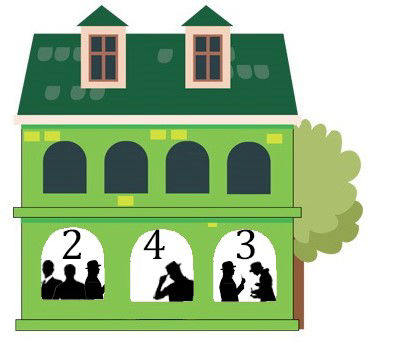Problems
Are there such irrational numbers \(a\) and \(b\) so that \(a > 1\), \(b > 1\), and \(\lfloor a^m\rfloor\) is different from \(\lfloor b^n\rfloor\) for any natural numbers \(m\) and \(n\)?
2022 dollars were placed into some wallets and the wallets were placed in some pockets. It is known that there are more wallets in total than there are dollars in any pocket. Is it true that there are more pockets than there are dollars in one of the wallets? You are not allowed to place wallets one inside the other.
Two players in turn paint the sides of an \(n\)-gon. The first one can paint the side that borders either zero or two colored sides, the second – the side that borders one painted side. The player who can not make a move loses. At what \(n\) can the second player win, no matter how the first player plays?
100 cars are parked along the right hand side of a road. Among them there are 30 red, 20 yellow, and 20 pink Mercedes. It is known that no two Mercedes of different colours are parked next to one another. Prove that there must be three Mercedes cars parked next to one another of the same colour somewhere along the road.
20 birds fly into a photographer’s studio – 8 starlings, 7 wagtails and 5 woodpeckers. Each time the photographer presses the shutter to take a photograph, one of the birds flies away and doesn’t come back. How many photographs can the photographer take to be sure that at the end there will be no fewer than 4 birds of one species and no less than 3 of another species remaining in the studio.
Is it possible to cut such a hole in \(10\times 10 \,\,cm^2\) piece of paper, though which you can step?
A square \(4 \times 4\) is called magic if all the numbers from 1 to 16 can be written into its cells in such a way that the sums of numbers in columns, rows and two diagonals are equal to each other. Sixth-grader Edwin began to make a magic square and written the number 1 in certain cell. His younger brother Theo decided to help him and put the numbers \(2\) and \(3\) in the cells adjacent to the number \(1\). Is it possible for Edwin to finish the magic square after such help?
The meeting of the secret agents took place in the green house.

Considering the numbers in the windows of the green house, what
should be drawn in the empty frame?

Pinoccio keeps his Golden Key in the safe that is locked with a
numerical password. For secure storage of the Key he replaced some
digits in the password by letters (in such a way that different letters
substitute different digits). After replacement Pinoccio got the
password \(QUANTISED17\). Honest John
found out that:
• the number \(QUANTISED\) is divisible
by all integers less than 17, and
• the difference \(QUA-NTI\) is
divisible by \(7\).
Could he find the password?
Decipher the quote from Philip Pullmans "His Dark Materials":
Erh csy wlepp orsa xli xvyxl, erh xli xvyxl wlepp qeoi csy jvii.
The same letters correspond to the same in the phrase, different letters
correspond to different. We know that no original letters stayed in
place, meaning that in places of e,r,h there was surely something
else.